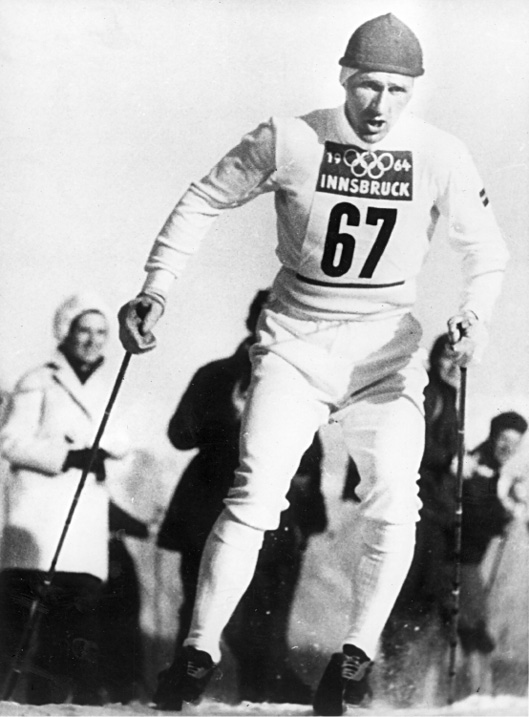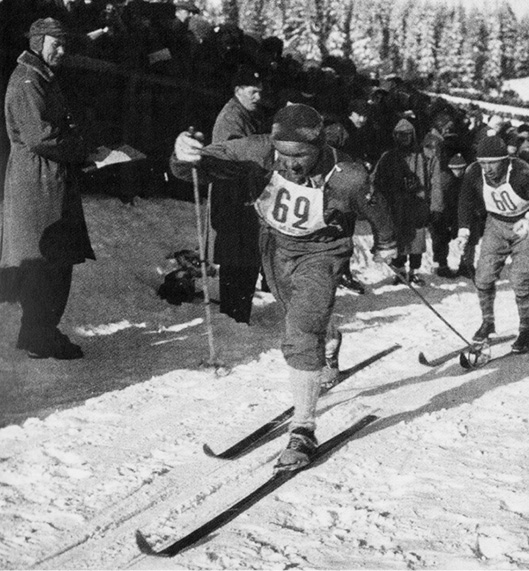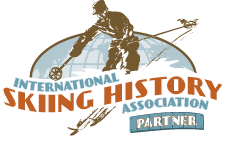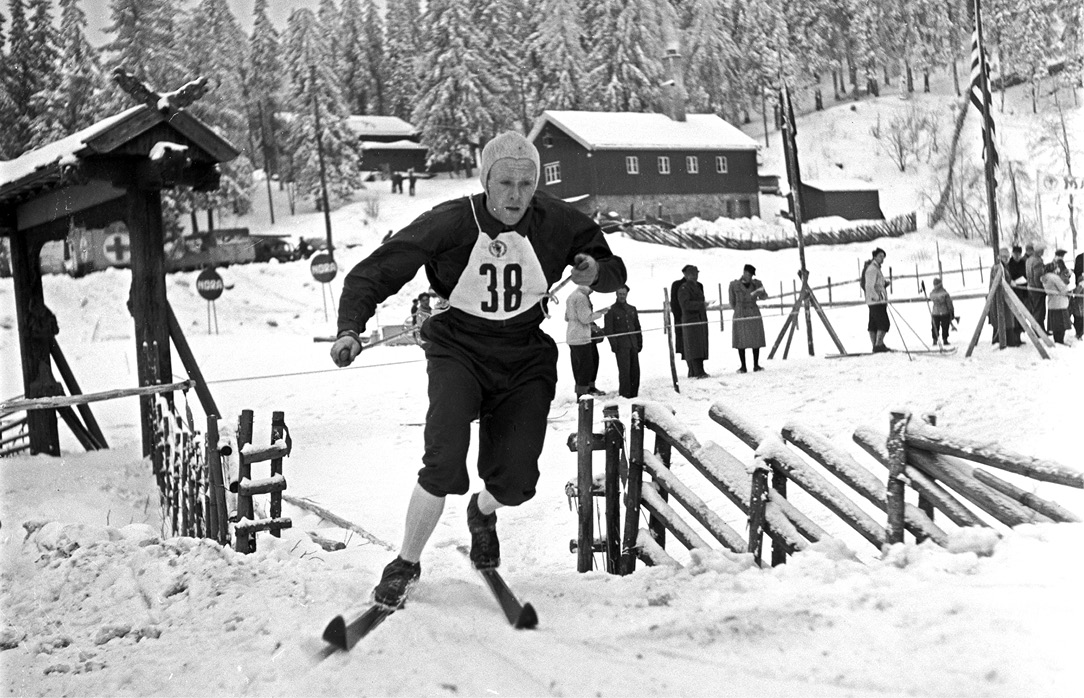
SKIING HISTORY
Editor Kathleen James
Art Director Edna Baker
Contributing Editor Greg Ditrinco
ISHA Website Editor Seth Masia
Editorial Board
Seth Masia, John Allen, Andy Bigford, John Caldwell, Jeremy Davis, Kirby Gilbert, Paul Hooge, Jeff Leich, Bob Soden, Ingrid Wicken
Founding Editors
Morten Lund, Glenn Parkinson
To preserve skiing history and to increase awareness of the sport’s heritage
ISHA Founder
Mason Beekley, 1927–2001
ISHA Board of Directors
Seth Masia, President
Wini Jones, Vice President
Jeff Blumenfeld, Vice President
John McMurtry, Vice President
Chan Morgan, Treasurer
Einar Sunde, Secretary
Richard Allen, Skip Beitzel, Michael Calderone, Christin Cooper, Art Currier, Dick Cutler, Chris Diamond, Mike Hundert, David Ingemie, Rick Moulton, Wilbur Rice, Charles Sanders, Bob Soden (Canada), Betty Tung
Presidential Circle
Christin Cooper, Billy Kidd, Jean-Claude Killy, Bode Miller, Doug Pfeiffer, Penny Pitou, Nancy Greene Raine
Business & Events Manager
Kathe Dillmann
P.O. Box 1064
Manchester Center VT 05255
(802) 362-1667
kathe@skiinghistory.org
Membership Services
Laurie Glover
(802) 375-1105
laurie@skiinghistory.org
Corporate Sponsorships
Peter Kirkpatrick
(541) 944-3095
peterk10950@gmail.com
Bimonthly journal and official publication of the International Skiing History Association (ISHA)
Partners: U.S. Ski and Snowboard Hall of Fame | Canadian Ski Museum and Hall of Fame
Alf Engen Ski Museum | North American Snowsports Journalists Association | Swiss Academic Ski Club
Skiing History (USPS No. 16-201, ISSN: 23293659) is published bimonthly by the International Skiing History Association, P.O. Box 1064, Manchester Center, VT 05255.
Periodicals postage paid at Manchester Center, VT and at additional mailing offices. Postmaster: Send address changes to ISHA, P.O. Box 1064, Manchester Center, VT 05255
ISHA is a 501(c)(3) public charity. EIN: 06-1347398
Written permission from the editor is required to reproduce, in any manner, the contents of Skiing History, either in full or in part.
Ski Like the Champions
In 1956, two Americans crisscrossed Scandinavia to film the world’s fastest Nordic racers and make the first-ever cross-country ski technique film.
One thing leads to another. In this case, a 1956 summer school course in Oslo landed a couple of Americans smack in the middle of the three biggest cross-country ski races in Scandinavia. It was the chance of a lifetime to make an instructional film showing how Scandinavian racers skied so much faster than anyone else in the world—especially those living back home, in the good old USA.
Photo top of page: Norwegian racer Håkon Brusveen, shown here in 1952, won two medals (gold and silver) at the 1960 Winter Olympics in Squaw Valley, California. Wikimedia Commons.
The story started the previous summer, as I bounced along on a student sightseeing tour of historical Norwegian landmarks. I saw Viking settlements, ancient stave churches and the famous longboats that took fierce raiders to distant lands. I also happened to meet Fritz Harshbarger, a first-class cinematographer. As we rumbled along, Fritz perched himself next to the bus door, motion-picture camera at the ready, the first off at each stop. Everywhere we went, and everything we did, was recorded for posterity on 16mm film. His mission: to provide Oslo University with great advertising footage to promote the summer school program and attract dozens of eager tuition-paying students.
Harshbarger was no ordinary camera-toting tourist. He took amateur filmmaking seriously, and had won a number of awards for his work. Once a collegiate basketball star, he had just completed his PhD in “rocket science” (jet propulsion) and was in Norway for 15 months on a Fulbright fellowship. Tall, lanky, with weathered face and broad smile, he could have passed as a Texas cowboy. And with a laugh you could hear a mile away, he sounded the part as well.
It was easy to strike up conversations with Fritz. I had been a cross-country racer at Middlebury College in Vermont, and when he learned of my interest in racing technique, the handwriting began forming on the wall. He was taking a year off and had two 16 mm cameras. I was a skier and coach who wanted to study cross-country racing technique. Having just completed two years of U.S. military service, I also had time. We became a team, and the more we talked, the more exciting the possibilities looked. Using two cameras, we wanted to film the biggest ski races, take pictures of all the best racers, and then put together an instructional film showing how to ski like the champions — arguably the first-ever cross-country technique film.
That was the plan. How it unfolded follows.
Fritz was sure that future audiences would tire of watching a parade of knicker-clad skiers. We needed a little comic interlude to liven things up. That’s how the “Cowboy on Skis” subplot was born. The script was pretty simple: Fritz, the Texas Cowboy, decked out in a flying scarf, broad brimmed hat, and wearing number O, enters the world-famous Holmenkollen race. But early on, it becomes obvious that the bouncing gait of the tall Texan will be no match for the powerful strides of the Scandinavians.
Luckily, the plot turns when the cowboy meets “The Beautiful Girl.” We found “Tova,” who had all the necessary attributes, plus a few more. What followed was love at first sight, culminating in a passionate trailside kiss that catapulted the fired-up cowboy to victory. As any sports psychologist will tell you, motivation is the key to success.
In the film, the cowboy was shown zooming up hills in a tuck position. How did we do that? First, we modified the back end of a pair of skis so they would slide backwards. After many practice runs, along with some pretty good falls, we got the footage. Later we edited the film by flipping it to produce reversed direction and splicing that section into the final edition. It worked! The cowboy coasted up hills on custom skis with curved tips that resembled a ram’s horn.
Alas, the cowboy subplot failed to amuse the elderly members of the Holmenkollen organizing committee. Perhaps the opening shot of the cowboy, standing in the starting gate of the Holmenkollen on a pair of ridiculous-looking skis, was too much for them to swallow. Norwegian pride, you know. But the committee did like the ski technique part of the film and once completed, the NSF (Norges Skiforbund) was the first to purchase a copy.
We had started planning our filming schedule in September 1956. We decided to focus on the marquee race in each of the three Scandinavian countries. Letters were written, phone calls were made, interviews took place and national coaches were consulted. The three national ski associations provided us with the necessary permissions. At every turn we were greeted with a friendly handshake. Many were quite enthusiastic, even flattered, that we wanted to film their racers. And, of course, national team coaches wanted to see the motion picture.
In late fall I took a trip to Vålådalen, a sports resort and training center in northern Sweden made famous by the legendary coach, Gosta Olander. Vålådalen is a resort like no other. Ordinary vacationers and world-class athletes mix freely, eating at the same tables and enjoying the same evening entertainment. There are facilities for all the major sports, enough to satisfy the most ardent fan. I chose to hang out with the Swedish cross-country team on one of their interval training days. Yes, they were very impressive, and yes, I learned a lot that day.
Later, the skiers showed up at the training room for their monthly bicycle ergometer test. They rode an adapted stationary bicycle that kept pedaling effort constant while heart rate was taken every minute. Calculations would show the amount of oxygen each skier can take in and send to his working muscles. In recent decades, science has become the basis for endurance training. The process was developed by the famous Swedish sports physiologist, Per-Olof Åstrand.

Endurance will always be the key that unlocks the door to cross-country skiing success. I was reminded of this truism one evening in Finland when the famous Finnish racer, Arnie Hiiva, and I were hanging out with a bunch of his friends. These guys had little formal schooling. They were loggers, or woodsmen, raised on farms, and accustomed to hard work. Many generations of this hardy outdoor lifestyle had evolved a genetic pool from which gold-medal winners were born. The takeaway for other countries? When it comes to physical endurance, the rest of us have a lot of catching up to do. Sixten Jernberg’s advice for Americans was simply put: “...endurance training, endurance training, and more endurance training.” A pretty clear message. Sixten’s own life gives us a perfect example. His formula was: Get up early, run or ski to work, chop and saw wood all day, run home and then train for two or three hours. Repeat six times a week for many years.
Jernberg was typical of the cross-country skiers we had the pleasure of associating with during our time in Scandinavia. These were honest, simple people, no frills. They asked for no favors but, on the other hand, were willing to give you the shirt off their backs. And I remember them as being patient—in fact, amazingly patient—with some of our crazy requests. A couple of them persuaded a neighbor to hitch up his horses and pull a sled, so Fritz could take long, uninterrupted pictures of them skiing in the field. When I asked Veikko Hakulinen to use diagonal stride the whole way, he said that was not the way he usually skied, but he did it anyway, just because I asked.
With four world titles and nine Olympic medals, Jernberg was one of the most decorated cross-country skiers of all time. He and his wife lived in a modest house, with one exception: the kitchen. Thanks to her husband’s race winnings, she had every appliance and kitchen convenience known to the civilized world.
Another time, when we were visiting Håkon Brusveen at his home in Lillehammer, I asked if we could film him sawing a log with a bucksaw. “Why does this crazy American want me to do that?” But there was a method in our madness: The slow-motion pictures of his sawing motion clearly showed the body initiating each stroke, with the arms following in a coordinated sequence. Good body mechanics produces a powerful and energy-saving sawing technique. I can’t imagine today’s Olympic champions taking time to do those things. We live in a much different age.

Saunas are big in Finland and are treated with respect bordering on reverence. The family sauna is given credit for everyone’s good health and recovery from fatigue. That last part is where Nordic skiers come in. One afternoon, members of the national team suggested that I join them. It’s funny how a trip to the sauna could turn into a ski-racing lesson: Hakulinen and his teammates could have been models for an anatomical wall chart. Hakulinen probably had zero percent body fat, and that was lesson number one: Lose the extra fat.
Lesson number two is not so obvious: You needed to notice that the flat muscle on the forward side of Hakulinen’s hips was exceptionally well developed. This is an important muscle for hip flexion, as in swinging the leg forward. The Hawk’s stride had a very fast leg recovery, a rapid swing-through that carried him forward onto the next glide. Repeated thousands of times, over many years, his hip flexion muscle had become strong and well defined, a hidden key to his success.
Dr. Birger Tvedt taught at the Oslo Orthopedic Institute and had a lifelong interest in the science of human movement. As Norway’s team doctor and physical therapist, he had a perfect opportunity to study the skiing technique of world-class athletes. He produced “training films” to help loggers and farmers benefit from his kinesiological understanding. Whether swinging an axe, cutting hay with a scythe, or sawing logs, good body mechanics affected how much work was done, effort used, and at what energy cost. It is fascinating to see how a small technique improvement makes a real impact on the day’s work.
The same in skiing. Good technique results in going fast and saving energy. Motion picture analysis, together with a coach’s trained eye, can help anyone who wants to ski better. Feeling the improvement is exciting and so the skier’s love of cross-country skiing increases. As we learned 60 years ago as amateur filmmakers in Scandinavia, the reward is in the doing. 
The technique instruction film described in this article was released over 60 years ago. It was 35 minutes long, in black and white, with English soundtrack. Copies were sold to a number of ski associations in Europe and Asia. In the United States, several college ski teams purchased it, as did the Vermont Ski Museum in Stowe. No other copies remain.
Rick Eliot is a former collegiate racer and coach who lives in Massachusetts. Thanks to ISHA editorial review-board member John Caldwell for his help in reviewing and editing this article.

Table of Contents
2020 Corporate Sponsors

World Championship
($3,000 and up)
Alyeska Resort
Gorsuch
Intuition Sports, Inc.
Obermeyer
Polartec
Warren and Laurie Miller
Snowsports Merchandising Corporation
World Cup ($1,000)
Active Interest Media | SKI & Skiing
Aspen Skiing Company
BEWI Productions
Bogner
Boyne Resorts
Country Ski & Sport
Dale of Norway
Darn Tough Vermont
Descente North America
Dynastar | Lange | Look
Fairbank Group: Bromley, Cranmore, Jiminy Peak
Fera International
Gordini USA Inc. | Kombi LTD
HEAD Wintersports
Hickory & Tweed Ski Shop
Mammoth Mountain
Marker-Völkl USA
National Ski Areas Association (NSAA)
Outdoor Retailer
POWDR Adventure Lifestyle Corp.
Rossignol
Ski Area Management
Sun Valley Resort
Vintage Ski World
World Cup Supply, Inc.
Gold ($700)
Race Place | BEAST Tuning Tools
The Ski Company (Rochester, NY)
Thule
Silver ($500)
Alta Ski Area
Clic Goggles
Dalbello Sports
Deer Valley
Ecosign Mountain Resort Planners
Hertel Ski Wax
Holiday Valley
Hotronic USA, Inc. | Wintersteiger
MasterFit Enterprises
Metropolitan New York Ski Council
Mt. Bachelor
NILS, Inc.
Portland Woolen Mills
Russell Mace Vacation Homes
Schoeller Textile USA
Scott Sports
Seirus Innovations
SeniorsSkiing.com
Ski Utah
Snow Time, Inc.
Sports Specialists, LTD
SympaTex
Tecnica Group USA
Timberline Lodge & Ski Area
Trapp Family Lodge
Vuarnet
Western Winter Sports Reps Association
World Pro Ski Tour
For information, contact: Peter Kirkpatrick | 541.944.3095 | peterk10950@gmail.com
ISHA deeply appreciates your generous support!


